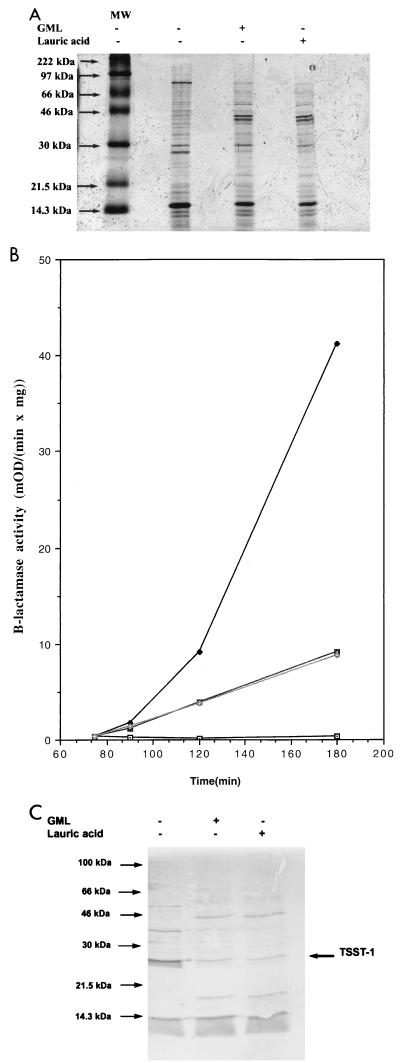FIG. 2.
Effects of GML and lauric acid on production of exoproteins, induction of β-lactamase synthesis, and production of TSST-1 in S. aureus. (A) Production of exoproteins. MN8 cultures were grown in broth with shaking with either GML, lauric acid, or no additives until the late-exponential phase (1,000 Klett units/ml). GML was added to 20 μg/ml at 0 min and to 10 μg/ml at 90, 150, 210 min. Lauric acid was added to 15 μg/ml at 0 min and to 7.5 μg/ml at 90, 150, and 210 min. Supernatants of final cultures were concentrated 10 times by precipitation with 10% trichloracetic acid, and proteins were separated by SDS-PAGE (12% polyacrylamide) and visualized by Coomassie staining. MW, molecular mass markers. (B) Induction of β-lactamase synthesis. Bacterial cultures (RN11) were grown in broth; equimolar subinhibitory amounts of GML (10 μg/ml) or lauric acid (7.5 μg/ml) were added at 0, 60, and 120 min; and β-lactamase inducer CBAP (carboxyphenylbenzoyl penicillanic acid) (5 μg/ml) was added at 75 min. Samples (1 ml) were collected at 60, 90, 120, and 180 min and assayed for β-lactamase activity. Each data point represents the average of two experiments. ⊡, no GML or lauric acid and no CBAP; ⧫, no GML or lauric acid and with CBAP added;  , GML and CBAP added; ◊, lauric acid and CBAP added. (C) Inhibition of TSST-1 production. Supernatants of MN8 cultures obtained as described for panel A were separated by SDS-PAGE (15% polyacrylamide). Separated proteins were transferred to a nitrocellulose filter (BA85; Schleicher & Schuell) and immunoblotted with anti-TSST-1 rabbit serum (kindly provided by P. Schlievert) according to the method of Blake et al. (1).
, GML and CBAP added; ◊, lauric acid and CBAP added. (C) Inhibition of TSST-1 production. Supernatants of MN8 cultures obtained as described for panel A were separated by SDS-PAGE (15% polyacrylamide). Separated proteins were transferred to a nitrocellulose filter (BA85; Schleicher & Schuell) and immunoblotted with anti-TSST-1 rabbit serum (kindly provided by P. Schlievert) according to the method of Blake et al. (1).

